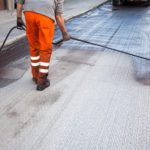Your new asphalt pavement can last as long as three decades if properly maintained — there is no better choice in terms of value and longevity. However, newly laid asphalt must be allowed to cool and dry before traffic can be allowed on it. In addition, you should wait at least three months before sealcoating your newly laid asphalt pavement.
Unlike concrete, which takes a few days to cure, fresh asphalt can be driven on as soon as it has cooled and dried. However, there are several factors to take into account before committing to a specific time frame for closing your asphalt pavement, including:
- The type of asphalt job that was done
- The air and ground temperature
- The size of the rollers used in the process
We recommend that you do not drive on your new asphalt pavement for at least 24 hours — if not until the following morning.
What’s the difference between drying and curing?
 Freshly laid asphalt takes months to fully cure after installation, during which time it is vulnerable to surface damage. However, it only takes 24–72 hours for the asphalt to dry sufficiently to allow foot and vehicle traffic — and resurfaced asphalt can dry in a matter of hours.
Freshly laid asphalt takes months to fully cure after installation, during which time it is vulnerable to surface damage. However, it only takes 24–72 hours for the asphalt to dry sufficiently to allow foot and vehicle traffic — and resurfaced asphalt can dry in a matter of hours.
While you can drive on newly installed or resurfaced asphalt within a few hours, it is recommended to wait at least overnight. In addition, depending on the weather, you should wait at least three months before sealcoating your asphalt pavement.
The drying and curing processes are both weather-dependent. In other words, harsh weather can cause the entire process to be delayed and even compromise the pavement’s structural stability before it fully cures. It is better to lay asphalt in the spring or early summer. The asphalt will begin to harden during cold temperatures even before the asphalt contractor has completed their job. This can result in bumps in your pavement.
What happens when the asphalt cures?

Asphalt is dark when it is first laid. However, it tends to turn gray over time as it loses its oils due to repeated sun exposure in a process known as oxidation. Because fresh asphalt contains excessive oil, oxidation is actually a good thing. It can help reduce tire scuffing or power steering marks on the asphalt.
What is the ideal period to wait before sealcoating your new asphalt?
You should wait at least 30 days after laying asphalt before sealcoating your commercial pavement, whereas it is best to wait 90 days for residential pavements. If you seal your new asphalt too soon, it will likely not have hardened enough to withstand the elements.
Why should you wait for your asphalt to cure before sealcoating?
You risk trapping in the lightweight oils that make your asphalt pavement flexible if you seal it before it has cured. As a result, your pavement becomes highly vulnerable to tire scuffing or power steering marks.
What are the risks of sealcoating too soon?

When fresh asphalt is sealed, the oxidation process is halted. So when you seal your asphalt pavement too soon, it retains a lot of the oils that make it flexible at first.
Specific weather conditions are necessary for asphalt sealcoating, and harsh weather conditions can severely impact the sealant’s performance. As a result, before commencing any sealcoating project, you must be mindful of the weather.
Because asphalt is flexible until it cures, it is crucial to maintain it properly. Keep these tips in mind:
- Avoid parking in the same spots repetitively.
- Avoid parking motorcycles or bicycles to prevent kickstands from sinking into the freshly laid pavement and leaving dents and scratches on the surface.
- Avoid driving heavy construction equipment on fresh asphalt.
- Oil and fuel stains on the pavement should be cleaned up right away since they can discolor asphalt and give it a sticky texture over time.
- Temperature fluctuations can cause the ground beneath the pavement to contract and expand over time, resulting in cracks on the asphalt surface. You should schedule regular asphalt inspections and have an asphalt contractor seal the cracks to avoid further deterioration.
Address
Commonwealth Paving, 136 Outerloop, Louisville, Kentucky 40214
Phone: 502-459-7283, Fax: 502-456-2678
Opening Hours
| Monday | 9:00 AM – 5:00 PM |
| Tuesday | 9:00 AM – 5:00 PM |
| Wednesday | 9:00 AM – 5:00 PM |
| Thursday | 9:00 AM – 5:00 PM |
| Friday | 9:00 AM – 5:00 PM |
| Saturday | Closed |
| Sunday | Closed |







